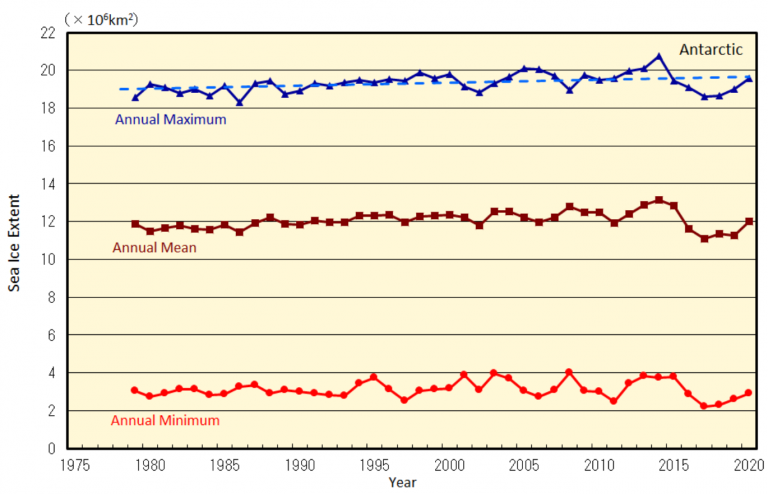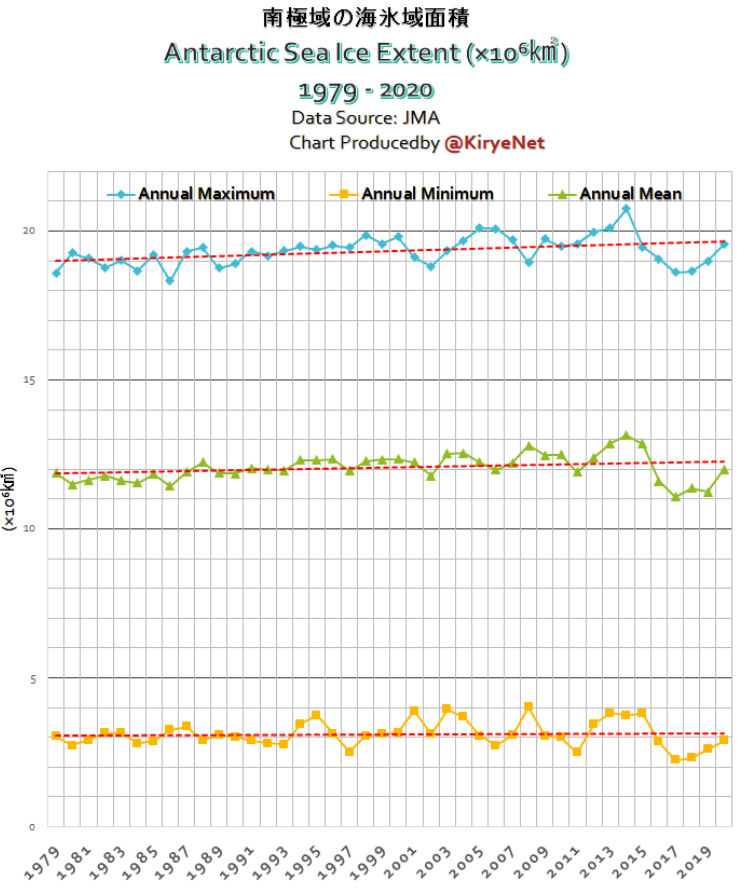By Kirye
and Pierre
Just a short post today about sea ice trends at Antarctica, a place that global warming alarmists don’t like talki9ng about
For some reason, the Japan Meteorological Agency (JMA) doesn’t add a trend line to the annual minimum and mean sea ice extent plot for Antarctica. 
So we’ve added these trend lines:

Data source: JMA
Minimum sea ice extent has remained steady over the past 4 decades. But both the mean and maximum sea ice extents have risen, meaning more ice at the South Pole.
More ice of course only forms when the temperature drops. Global warming has yet to reach the South Pole. This is one of the most inconvenient regions on the planet for the global warming alarmists.





I mostly agree but still:
”More ice of course only forms when the temperature drops.”
Wrong! More ice forms when the annual average temperature is below the equilibrium for more ice to form!
It is perfectly possible for ice to decrease during a period of stable, but above equilibrium temperature. Just as it is for ice to increase during a period of stable but below equilibrium temperatures!
Not a lot of people know that.
On of the main predictions that Anthropogenic Global Warming Theory (AGW) made is that global warming will be more noticeable in the poles and their surrounding areas than elsewhere.
What Kirye and Pierre show here is that AGW theory failed in this prediction, which by no means imply that it succeeded in predicting anything else. Bottom line, AGW has nothing show as far as facts are concerned. It’s fraud-based science.
[…] Zdroj: https://notrickszone.com/2021/08/28/the-most-inconvenient-region-on-the-planet-for-global-warming-al… […]
I note there is a 4 C degree thing going around, such as:
“A third of Antarctica’ s vast offshore ice shelves could collapse into the ocean if the world warms by 4 degrees Celsius (7.2 degrees Fahrenheit) above pre-industrial levels.”
That’s from livescience but I guess the study making the rounds was from the University of Reading – lead study author Ella Gilbert.
Is the 4C° thing a new WAG, or part of the hype leading to the Council of the Parties in Glasgow?
Section B.2.5. of the latest IPCC report does refer to the Arctic and Antarctic
“The Arctic is likely to be practically sea ice free at least once before 2050 under the five illustrative scenarios considered in this report”
“There is low confidence in the projected decrease of Antarctic sea ice.”
To use consistent language they should have said:-
“We are unlikely to see any decrease in Antarctic sea ice”
Antarctica isn’t impacted by the Urban Heat Island Effect, Water Vapor, and it has a near-constant albedo. It is the ideal location to isolate the impact of rising CO2 on temperature. What happens when you isolate the locations that are “controlled” for the exogenous factors of the UHI, Water Vapor and changing Albedo? You get no warming whatsoever, None, Nada, Zip. Why haven’t you need shown this evidence? There is no money to be made debunking this CO2 drives temperature myth. Here is all the evidence you need to demonstrate CO2 doesn’t materially impact temperatures.
https://imgur.com/a/CDasqHH
More Evidence of the Myth”
https://imgur.com/a/siHPINY
[…] Reposted from the NoTricksZone […]
[…] Reposted from the NoTricksZone […]
It is late August and we are coming to the end of the Austral Winter.
Here is what you need to make a lot of sea ice in the Southern Ocean in winter.
1. An ice-bound polar-located island continent with an average surface elevation of 2 km.
2. A planetary rotation induced polar atmospheric vortex.
3. Cold air, lots of it, generated by surface to space radiative cooling of the high elevation ice cap in winter.
4. Down-slope air drainage of the cold air by katabatic winds that sweep out from the continent and induce a process of air blast freezing that generates sea ice out across the surface of the Southern Ocean.
Basic meteorology. See Dome Argus Weather Station Temperature Profiles from 09 May to 17 Dec 2008
[…] Reposted from the NoTricksZone […]
[…] Fonte: No Tricks Zone […]
[…] to the Japan Meteorological Agency, the continent’s annual maximum sea ice has grown for three straight years. The annual mean is increasing, and the annual minimum has also expanded […]
“More ice of course only forms when the temperature drops.”
This is factually incorrect. The freezing point of saltwater and freshwater is different, thus a change in salinity can alter the amount of ice that forms.
Please add a correction to your post.